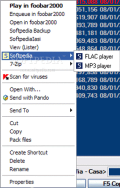How many computer users wish a change in the context menu provided by Windows? Most of us would like to customize it to our own whim and create a whole lot more options to be available in there. And yet the number of programs capable of offering the necessary options are not at all many.
Some of the softwares we install on our computer provide integration in Windows' context menu (7-Zip, Kaspersky, Counter Spy, etc.), but most of them don't. And some of the installed applications are a bit hard to reach in some cases.
Fast Explorer is designed to correct this problem and give the user access to a variety of objects Windows' interface does not. It gives the user the chance to include his/her own options in the context menus and handlers. Besides this function, Fast Explorer will also scan your registry and display a list of bugs detected. For a fast and time saving cleaning of the registry, this menu is equipped with a "Fix All" function that will automatically eliminate the unwanted values from your registry.
Fast Explorer is free to use and very easy to handle. However, some users may feel the need of a tutorial or a help menu explaining how exactly Fast Explorer works. It actually makes new entries in the registry. This can also be achieved manually by more advanced users, but beginners should have a chance to this the easy way.
With a bit over 550KB installer, Fast Explorer is a very good solution for adding your own options in Windows context menu. When launching the software, it'll read the existing menu configuration from the registry and proceed to inserting the new configuration. The best part of the software is that it manages context menu items of file objects displayed in any application that supports shell's API (application programming interface).
The easy to use interface provides quick access to creating both static and dynamic menus. Its flexibility goes as far as creating sub-menus and adding separators. The four menus available in the main application window include options for managing static items, sub-menu items, cleanup the static items and the shell extensions.
Combined with the "Registry Bugs!" feature, you can safely employ Fast Explorer for cleaning the file associations and create menus for different files and applications for faster access.
Adding a static element should take a very small amount of time as there is nothing complicated about it. All you have to do is press the "Add" button and choose an executable file you want to run from the context menu. The user can rename it and associate it with a certain type of files, with folders or with all folders.
Now the Submenu Items tab is really something. This is the menu with the most options and here you can do exactly the same as in the precedent tab, only you have greater flexibility. The menu created in here is dynamic and is available only when certain file types are detected. You can choose certain file types to be associated with or you can associate the executable with all the files.
The novelty consists in the fact that each item can be given a representative icon. This can be selected either from those provided by Windows in system32 folder (shell32.dll) or from a user defined location. The icon must be in ICO format and the software automatically extracts it from the executables or libraries (DLL, BPL, AX, OCX or VBX).
Additionally, the customizing option allows enabling custom-drawn menu items. The changes to be done in here include modifying the text (indentation, font, color in normal mode and when selected), the colors for the item and icon background (both in normal mode and when selected).
Sometimes when uninstalling a software that created a static menu in Windows shell, the item may not disappear completely. The two cleanup options available in Fast Explorer come in handy in this case as they will help you eliminate those menu items that are no longer needed or functioning. All you need to do is select a file entry and the application will display the static menus associated with it.
Shell Extensions Cleanup functions in exactly the same way only this time the shell extensions are at stake. In my case, I successfully deleted some items that were no longer associated with a program but lingered in the registry. The refresh option allows you to see if the modification has taken effect or not. Unfortunately, not all the elements I wanted eliminated were indeed erased from the registry and the refresh option proved me that. However, Fast Explorer gives you the complete registry key and you can manually delete those entries.
The Good
The application gives the beginner users the chance to access faster certain softwares directly from Windows shell. There is no need for complicated operations in the registry as Fast Explorer will do everything for you nice and clean.
The Bad
Not all the shell extensions were deleted from the registry and sometimes, you will have to resort to the manual way to do it.
The lack of a help menu may make some users feel overcome by the situation.
The Truth
The application is free and extremely easy to handle. However, a bit of explaining o how the application works and what are the changes operated in the registry would make it more popular among neophytes. A bit of explaining of the items available and working with the dynamic menu would do a lot of good to some of the users.
Here are some snapshots of the application in action:
 14 DAY TRIAL //
14 DAY TRIAL // 





